炼钢生产成本明细账(填写样本)
- 格式:xls
- 大小:342.50 KB
- 文档页数:2
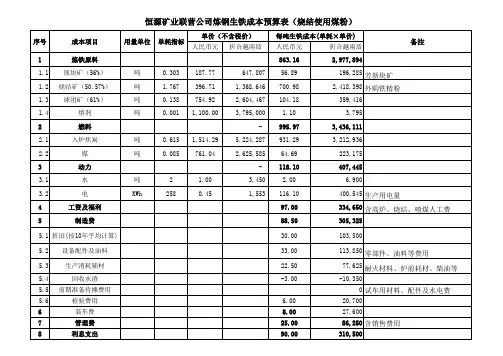
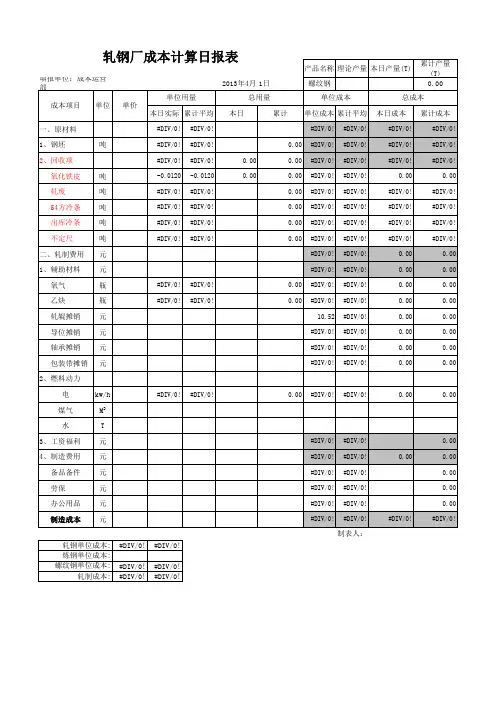
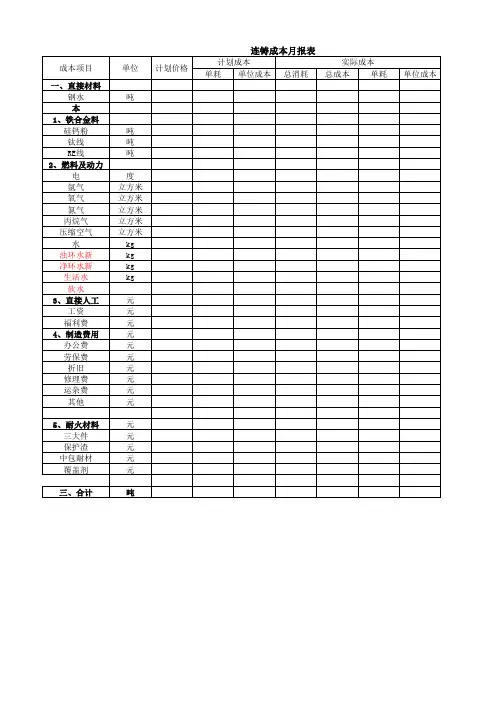
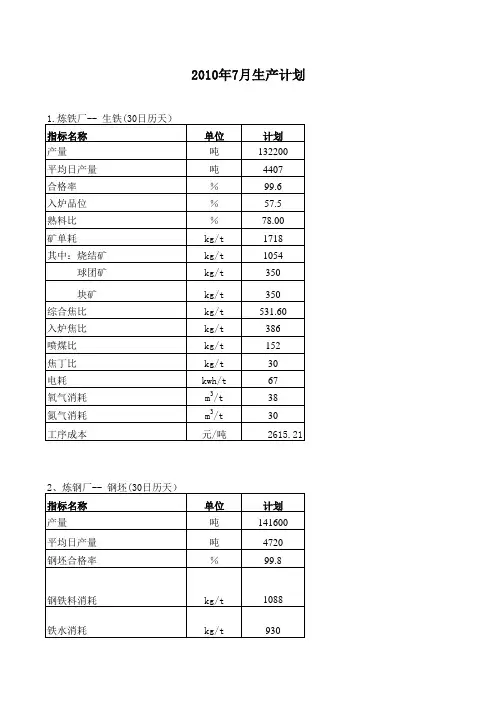
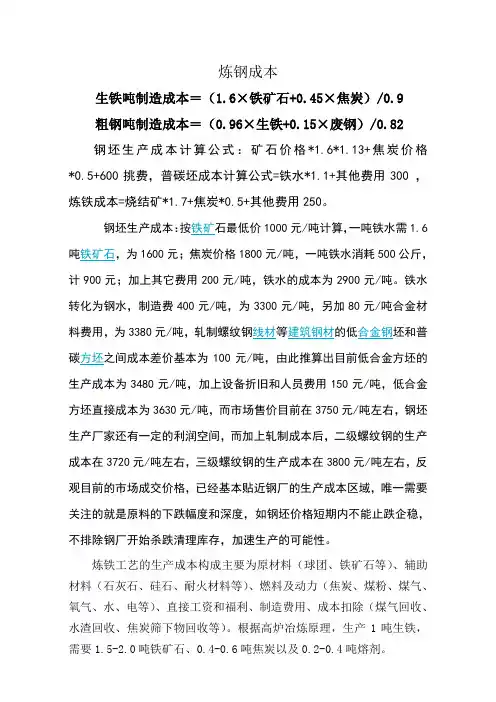
炼钢成本生铁吨制造成本=(1.6×铁矿石+0.45×焦炭)/0.9粗钢吨制造成本=(0.96×生铁+0.15×废钢)/0.82钢坯生产成本计算公式:矿石价格*1.6*1.13+焦炭价格*0.5+600挑费,普碳坯成本计算公式=铁水*1.1+其他费用300 ,炼铁成本=烧结矿*1.7+焦炭*0.5+其他费用250。
钢坯生产成本:按铁矿石最低价1000元/吨计算,一吨铁水需1.6吨铁矿石,为1600元;焦炭价格1800元/吨,一吨铁水消耗500公斤,计900元;加上其它费用200元/吨,铁水的成本为2900元/吨。
铁水转化为钢水,制造费400元/吨,为3300元/吨,另加80元/吨合金材料费用,为3380元/吨,轧制螺纹钢线材等建筑钢材的低合金钢坯和普碳方坯之间成本差价基本为100元/吨,由此推算出目前低合金方坯的生产成本为3480元/吨,加上设备折旧和人员费用150元/吨,低合金方坯直接成本为3630元/吨,而市场售价目前在3750元/吨左右,钢坯生产厂家还有一定的利润空间,而加上轧制成本后,二级螺纹钢的生产成本在3720元/吨左右,三级螺纹钢的生产成本在3800元/吨左右,反观目前的市场成交价格,已经基本贴近钢厂的生产成本区域,唯一需要关注的就是原料的下跌幅度和深度,如钢坯价格短期内不能止跌企稳,不排除钢厂开始杀跌清理库存,加速生产的可能性。
炼铁工艺的生产成本构成主要为原材料(球团、铁矿石等)、辅助材料(石灰石、硅石、耐火材料等)、燃料及动力(焦炭、煤粉、煤气、氧气、水、电等)、直接工资和福利、制造费用、成本扣除(煤气回收、水渣回收、焦炭筛下物回收等)。
根据高炉冶炼原理,生产1吨生铁,需要1.5-2.0吨铁矿石、0.4-0.6吨焦炭以及0.2-0.4吨熔剂。
炼钢工艺的生产成本构成主要为生铁、废钢、合金、电极、耐火材料、辅助材料、电能、维检和其他等费用。
中国目前主要的炼钢设备为转炉和电炉,基于冶炼原理的不同,转炉和电炉在主要的原料(生铁、废钢)配比有一定的差异,转炉工艺一般需配置10%的废钢,而电炉工艺废钢的使用量则占到80%。

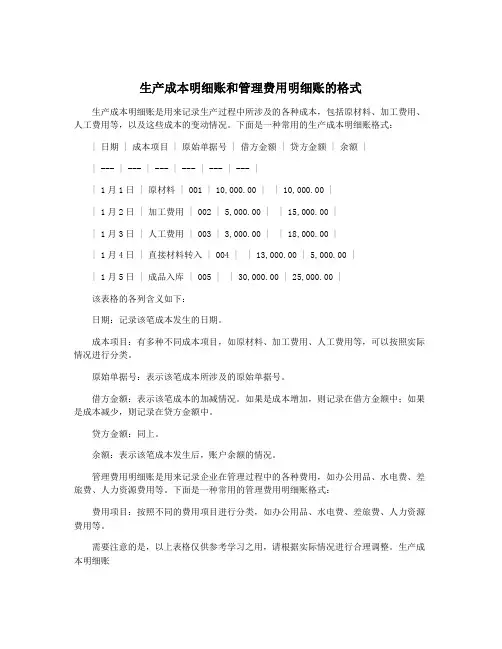
生产成本明细账和管理费用明细账的格式生产成本明细账是用来记录生产过程中所涉及的各种成本,包括原材料、加工费用、人工费用等,以及这些成本的变动情况。
下面是一种常用的生产成本明细账格式:| 日期 | 成本项目 | 原始单据号 | 借方金额 | 贷方金额 | 余额 || --- | --- | --- | --- | --- | --- || 1月1日 | 原材料 | 001 | 10,000.00 | | 10,000.00 || 1月2日 | 加工费用 | 002 | 5,000.00 | | 15,000.00 || 1月3日 | 人工费用 | 003 | 3,000.00 | | 18,000.00 || 1月4日 | 直接材料转入 | 004 | | 13,000.00 | 5,000.00 || 1月5日 | 成品入库 | 005 | | 30,000.00 | 25,000.00 |该表格的各列含义如下:日期:记录该笔成本发生的日期。
成本项目:有多种不同成本项目,如原材料、加工费用、人工费用等,可以按照实际情况进行分类。
原始单据号:表示该笔成本所涉及的原始单据号。
借方金额:表示该笔成本的加减情况。
如果是成本增加,则记录在借方金额中;如果是成本减少,则记录在贷方金额中。
贷方金额:同上。
余额:表示该笔成本发生后,账户余额的情况。
管理费用明细账是用来记录企业在管理过程中的各种费用,如办公用品、水电费、差旅费、人力资源费用等。
下面是一种常用的管理费用明细账格式:费用项目:按照不同的费用项目进行分类,如办公用品、水电费、差旅费、人力资源费用等。
需要注意的是,以上表格仅供参考学习之用,请根据实际情况进行合理调整。
生产成本明细账生产成本明细账是企业在生产过程中所记录的重要账目之一,它直接反映了生产过程中所涉及的各种成本及其变动情况,所以对于企业来说是非常重要的。
1. 要根据实际情况合理分类记录:生产成本包括原材料、加工费用、人工费用等等,可以按照不同的成本项目进行分类记录,以方便进行统计分析和对应的会计处理。

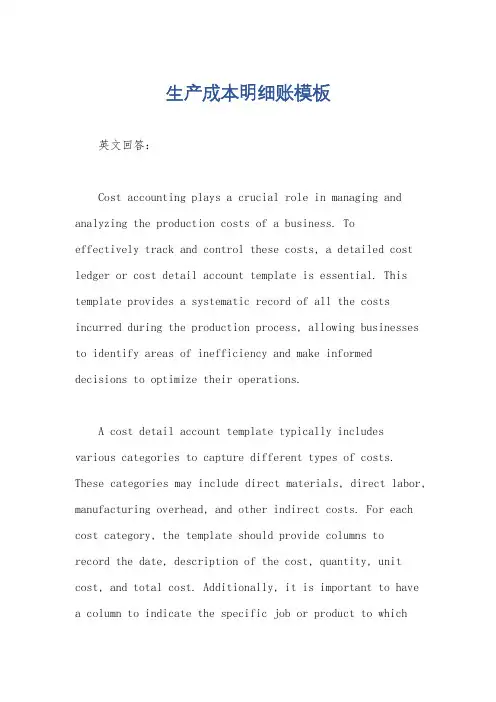
生产成本明细账模板英文回答:Cost accounting plays a crucial role in managing and analyzing the production costs of a business. Toeffectively track and control these costs, a detailed cost ledger or cost detail account template is essential. This template provides a systematic record of all the costs incurred during the production process, allowing businesses to identify areas of inefficiency and make informed decisions to optimize their operations.A cost detail account template typically includes various categories to capture different types of costs. These categories may include direct materials, direct labor, manufacturing overhead, and other indirect costs. For each cost category, the template should provide columns torecord the date, description of the cost, quantity, unit cost, and total cost. Additionally, it is important to have a column to indicate the specific job or product to whichthe cost is allocated.Let's take the example of a manufacturing company that produces furniture. The cost detail account template for this company would have separate sections for direct materials, direct labor, and manufacturing overhead. Under the direct materials section, the template would include columns to record the date of purchase, description of the material, quantity purchased, unit cost, and total cost. For instance, if the company purchases wood for making chairs, the template would show the date of purchase, the description of the wood, the quantity purchased (e.g., 100 board feet), the unit cost (e.g., $5 per board foot), and the total cost (e.g., $500).Similarly, the direct labor section of the template would capture the labor costs associated with the production process. It would include columns for the date of labor, description of the work performed, hours worked, hourly rate, and total labor cost. For example, if a worker spends 8 hours assembling chairs at an hourly rate of $20, the template would record the date, the description of thework (e.g., chair assembly), the hours worked (8), thehourly rate ($20), and the total labor cost ($160).The manufacturing overhead section of the templatewould account for indirect costs such as utilities, rent, and equipment depreciation. It would include columns forthe date, description of the overhead cost, allocation base (e.g., direct labor hours or machine hours), allocation rate, and total overhead cost. For instance, if the company allocates overhead costs based on direct labor hours andthe allocation rate is $10 per hour, the template would record the date, the description of the overhead cost (e.g., electricity bill), the allocation base (e.g., 20 directlabor hours), the allocation rate ($10 per hour), and the total overhead cost ($200).By using a cost detail account template, businesses can easily summarize and analyze their production costs. They can calculate the total cost per unit for each job or product, identify cost variances, and make informed decisions to improve efficiency and profitability.中文回答:成本会计在管理和分析企业生产成本方面起着至关重要的作用。
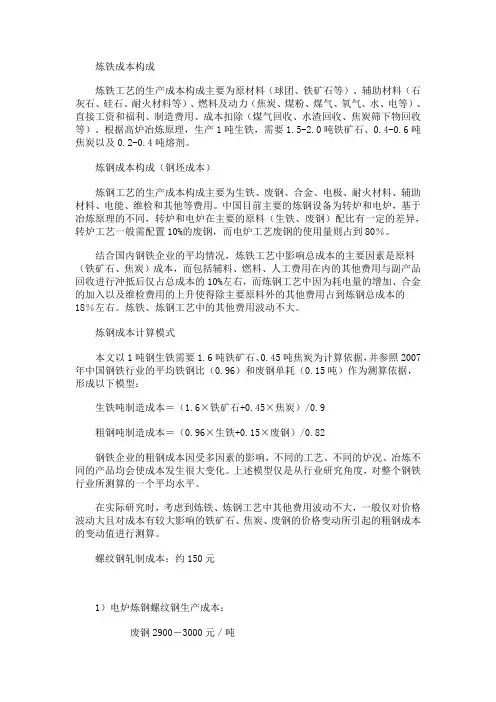
炼铁成本构成炼铁工艺的生产成本构成主要为原材料(球团、铁矿石等)、辅助材料(石灰石、硅石、耐火材料等)、燃料及动力(焦炭、煤粉、煤气、氧气、水、电等)、直接工资和福利、制造费用、成本扣除(煤气回收、水渣回收、焦炭筛下物回收等)。
根据高炉冶炼原理,生产1吨生铁,需要1.5-2.0吨铁矿石、0.4-0.6吨焦炭以及0.2-0.4吨熔剂。
炼钢成本构成(钢坯成本)炼钢工艺的生产成本构成主要为生铁、废钢、合金、电极、耐火材料、辅助材料、电能、维检和其他等费用。
中国目前主要的炼钢设备为转炉和电炉,基于冶炼原理的不同,转炉和电炉在主要的原料(生铁、废钢)配比有一定的差异,转炉工艺一般需配置10%的废钢,而电炉工艺废钢的使用量则占到80%。
结合国内钢铁企业的平均情况,炼铁工艺中影响总成本的主要因素是原料(铁矿石、焦炭)成本,而包括辅料、燃料、人工费用在内的其他费用与副产品回收进行冲抵后仅占总成本的10%左右,而炼钢工艺中因为耗电量的增加、合金的加入以及维检费用的上升使得除主要原料外的其他费用占到炼钢总成本的18%左右。
炼铁、炼钢工艺中的其他费用波动不大。
炼钢成本计算模式本文以1吨钢生铁需要1.6吨铁矿石、0.45吨焦炭为计算依据,并参照2007年中国钢铁行业的平均铁钢比(0.96)和废钢单耗(0.15吨)作为测算依据,形成以下模型:生铁吨制造成本=(1.6×铁矿石+0.45×焦炭)/0.9粗钢吨制造成本=(0.96×生铁+0.15×废钢)/0.82钢铁企业的粗钢成本因受多因素的影响,不同的工艺、不同的炉况、冶炼不同的产品均会使成本发生很大变化。
上述模型仅是从行业研究角度,对整个钢铁行业所测算的一个平均水平。
在实际研究时,考虑到炼铁、炼钢工艺中其他费用波动不大,一般仅对价格波动大且对成本有较大影响的铁矿石、焦炭、废钢的价格变动所引起的粗钢成本的变动值进行测算。
螺纹钢轧制成本:约150元1)电炉炼钢螺纹钢生产成本:废钢2900-3000元/吨电炉消耗废钢成本:(1:1.1)(2900-3000)*1.1=(3190-3300)元电耗:400度/吨*0.7元/吨=280元其他:350元(铁合金,电极,耐材等)20MnSi连铸坯价格在3820-3930元/吨螺纹钢轧制成本在150元/吨电炉炼钢螺纹钢最终成本为3970元/吨-4080元/吨2)转炉炼钢螺纹钢生产成本:铁精粉66%按照1560元/吨计算,烧结矿按照1700元/吨计算,矿和焦按照75%和25%的比例混合。
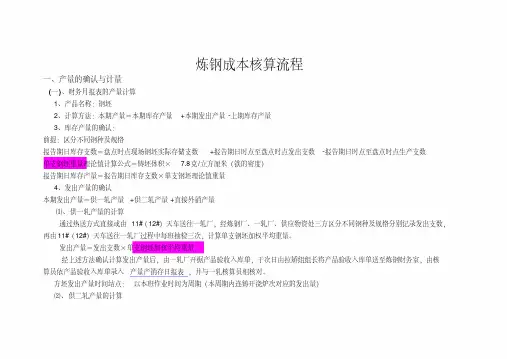
直接材料6931汇总并结转发出原材料成本2000002000007031汇总并结转发出原材料成本差异-10000-100007131分配并结转工资费用800007331计提并结转由企业负担的五险一金286407431计提并结转三项费用148007531分配并结转水电费用240007831归集、分配并结转制造费用96000生产费用合计4334401900007931结转铸造车间完工半成品成本-433440-190000月末在产品成本0直接材料6931汇总并结转发出原材料成本2400002400007031汇总并结转发出原材料成本差异-12000-120007131分配并结转工资费用1200007331计提并结转由企业负担的五险一金429607431计提并结转三项费用222007531分配并结转水电费用160007831归集、分配并结转制造费用144000生产费用合计5731602280007931结转铸造车间完工半成品成本-573160-228000月末在产品成本借方发生额借方发生额凭证字号凭证字号题号题号基本生产 明细账成本计算对象:铝铸件月初在产品:无 本月投产100件: 本月完工:100件 月末在产品成日期摘要基本生产 明细账成本计算对象:铁铸件月初在产品:无 本月投产100件: 本月完工:100件 月末在产品:无成日期摘 要直接人工1月初余额146969323997131分配并结转工资费用1350001350007331计提并结转由企业负担的五险一金48330483307431计提并结转三项费用24975249757531分配并结转水电费用180007831归集、分配并结转制造费用1633508031计算并结转领用及销售半成品成本347200本月发生的生产费用736855208305生产费用合计8838242407048031金工车间完工自制半成品直接转移-597600-180528月末在产品成本28622460176直接人工1月初余额179891356617131分配并结转工资费用1650001650007331计提并结转由企业负担的五险一金59070590707431计提并结转三项费用30525305257531分配并结转水电费用120007831归集、分配并结转制造费用199650借方借方发生额凭证字号凭证字号题号题号月初在产品:20件 本月投产80件: 本月完工:60件 月末在产品日期摘要基本生产 明细账成本计算对象:铁制零部件月初在产品:20件 本月投产80: 本月完工:60件 月末在产品:基本生产 明细账成本计算对象:铝材零部件日期摘要8031计算并结转领用及销售半成品成本458400本月发生的生产费用924645254595生产费用合计11045362902568031金工车间完工自制半成品直接转移-742500-217692月末在产品成本36203672564数量60直接材料1月初余额14461004116006931汇总并结转发出原材料成本6300006300007031汇总并结转发出原材料成本差异25200252007131分配并结转工资费用2000007331计提并结转由企业负担的五险一金716007431计提并结转三项费用370007531分配并结转水电费用100007831归集、分配并结转制造费用2580008031金工车间完工自制半成品直接转移1340100本月发生的生产费用2571900655200生产费用合计40180001066800摘要借方发生额应借账户日期凭证字号基本生产成本——XA型铣床基本生产 明细账成本计算对象:XC A铣床月初在产品:40台 本月投产60件: 本月完工:80件 月题号零部件直接转移成本计铁制零部8231结转装配车间完工产品成本-3280000-853440月末在产品成本738000213360:无成本项目直接人工制造费用8000028640148002400096000123440120000-123440-12000000在产品:无成本项目直接人工制造费用120000429602220016000144000185160160000-185160-16000000产品:40成本项目制造费用半成品266508792018000163350347200181350347200208000435120-156000-26107252000174048在产品:40成本项目制造费用半成品2995011428012000199650458400211650458400241600572680-181200-34360860400229072金额数量金额597600607425001340100直接人工制造费用半成品8560075800873100200000716003700010000258000134010030860026800013401003942003438002213200月末在产品:20成本项目成本计算表应贷账户:基本生产成本制零部件铝材零部件合计-350400-305600-1770560 4380038200442640。